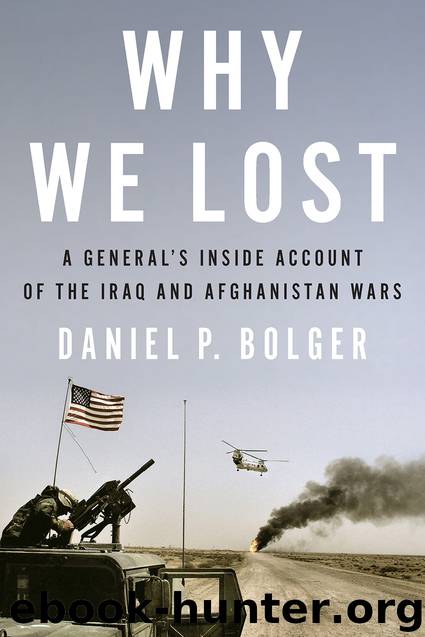Why We Lost by Daniel Bolger

Author:Daniel Bolger
Language: eng
Format: epub
Publisher: Houghton Mifflin Harcourt
General David Petraeus took command on February 10, 2007. Within days, he was at Camp Ramadi, his first troop visit. “I’m so happy I could kiss you guys,” he exclaimed. The MNF-I commander immediately saw the promise of the Sahwa. The CIA had written about it in the fall, and President Bush had even mentioned it in his January 10, 2007, announcement of the surge. Petraeus saw it was for real. He wanted to spread it to the other Sunni Arabs, starting in Baghdad. The American troop surge would pass. So too would the Americans. But the Sunni Arab surge had legs. It epitomized al-Qaeda out, Sunni in, and Iraqis increasingly in the lead.
Captain Travis Patriquin did not live to meet Petraeus. On December 6, 2006, less than two weeks after the Sufiyah clash, a random IED explosion in Ramadi killed Patriquin and two other Americans. Sheikh Sattar attended the memorial ceremony at Camp Ramadi, as did many other sheikhs, Iraqi police, and Iraqi soldiers. Sattar called Patriquin Hisham (the Pulverizer) Abu Risha, and the IPs named a substation for him in Ramadi. Sattar himself was killed by an AQI bombing on September 18, 2007. Though Patriquin and Sattar were no more, the great work they began together continued.
The Sunni Awakening expanded rapidly. As the Americans fought their way into various Baghdad neighborhoods and into the city’s rural belts, Sunni Arabs came forward. Whereas in Anbar, the Marines had enlisted the tribal men as police, in other areas, the Sunni took different titles, such as security contractors, neighborhood watch, and concerned local citizens. Ever conscious of marketing, Petraeus and his inner circle settled on a more inspirational name. With the approval of Prime Minister Nouri al-Maliki, the Sunni became the Sons of Iraq.
None dared call them what they really were: a Sunni militia. For the first time since the 2003 invasion, the Sunni Arabs matched the other two major political players in country. Before Petraeus took over, Senator (later Vice President) Joseph Biden had proposed a federal Iraq, formally split among Sunni Arabs, Shia Arabs, and Kurds. Many objected to the Biden formula, though it had been employed by the Ottoman Turks and the British in their day. In the spring of 2007, without an announcement, the Americans accepted a version of it.
The Sons of Iraq completed the Iraqi factional lineup. Each of the three Iraqi groups now featured political wings and de facto authorized militias separate from the formal Iraqi military and police. The Kurdish Democratic Party and the Patriotic Union of Kurdistan both owned heavily armed peshmerga units. The Shia Sadrists ran candidates under the Office of the Martyr Sadr and fielded Jaysh al-Mahdi elements in Shiite regions. Shia supporters of the Supreme Council for the Islamic Revolution in Iraq kept their Badr Corps, forever salting selected members into the Ministries of Defense and Interior. Now the Sunni hosted the Sahwa, an Anbar-based political movement with an American-equipped militia. Each community balanced the others. Combined with the troop
Download
This site does not store any files on its server. We only index and link to content provided by other sites. Please contact the content providers to delete copyright contents if any and email us, we'll remove relevant links or contents immediately.
The Radium Girls by Kate Moore(10924)
The Templars by Dan Jones(4199)
100 Deadly Skills by Clint Emerson(4093)
Rise and Kill First by Ronen Bergman(4026)
The Doomsday Machine by Daniel Ellsberg(3743)
The Rape of Nanking by Iris Chang(3530)
Killing England by Bill O'Reilly(3467)
Hitler in Los Angeles by Steven J. Ross(3450)
Stalin by Stephen Kotkin(3095)
12 Strong by Doug Stanton(3064)
Hitler's Monsters by Eric Kurlander(2741)
Darkest Hour by Anthony McCarten(2655)
Blood and Sand by Alex Von Tunzelmann(2615)
The Art of War Visualized by Jessica Hagy(2424)
Hitler's Flying Saucers: A Guide to German Flying Discs of the Second World War by Stevens Henry(2306)
The Code Book by Simon Singh(2222)
The Second World Wars by Victor Davis Hanson(2140)
Babylon's Ark by Lawrence Anthony(2078)
Tobruk by Peter Fitzsimons(2068)
